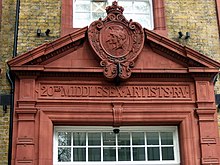Artists Rifles
The Artists Rifles (originally with Apostroph Artists' Rifles ) were a regiment of the reserve of the British Army that existed from 1859 to 1945 under various names , which was characterized by its special composition. His relatives were initially mostly people from artistic professions in the broader sense, including painters, sculptors, engravers, musicians and actors, later lawyers, architects, doctors and engineers dominated.
The regiment was used in the Second Boer War and World War I , while it served as a training unit for officers in World War II . Today's 21 Special Air Service Regiment (Artists) (Reserve) and the 23 Special Air Service Regiment (Reserve) are in the tradition of the Artists Rifles.
history
The regiment began to form in 1859 in response to a call from Secretary of War Jonathan Peel to the then British government under Lord Derby for the creation of voluntary rifle corps. The background was a feared invasion by the continental power France after the assassination attempt by Felice Orsini on the French Emperor Napoleon III. of January 1858 and the protracted political affair that followed.
The idea to found the Artists Rifles came from the art student Edward Sterling, who organized the group in London. On February 28, 1860 she was formally declared the 38th Middlesex (Artists') Rifle Volunteer Corps , her headquarters were initially in the Argyle Rooms on Regent Street , later in Burlington House on Piccadilly in London. The first directors of the corps were the painters Henry Wyndham Phillips and Frederic Leighton . The badge of the corps, designed by the royal medalist JW Wyon, shows the Roman gods Mars (god of war) and Minerva (goddess of wisdom), the motto was Cum Marte Minerva , which was also the title of the first regimental march. The color of the uniform was light gray with a white lapel and silver buttons.
The members of the corps were obliged to pay an admission fee and an annual membership fee. The officers were chosen by themselves and their names were given to the respective Lord Lieutenant who issued the officers' certificates.
In 1881 the name of the regiment was changed to The 20th Middlesex (Artists') Rifle Volunteers , the regiment became part of the Rifle Brigade (Prince Consort's Own) . In 1889 the proceeds were used to finance the construction of a permanent headquarters located on Duke's Road near Euston Road.
In the Second Boer War , the regiment was used from 1900 to 1901 as part of the City of London Imperial Volunteers in South Africa.

Under the Territorial and Reserve Forces Act of 1907, the regiment was reformed to the 28th County of London Battalion (Artists' Rifles) , which was part of the London Regiment . By 1914 twelve companies and three battalions had been set up. The 1/28 Battalion was mobilized in 1914 and shipped to France in October of that year. Upon arrival, more than 50 members of the battalion were immediately appointed officers to make up for the BEF's heavy loss of officers. In total, over 10,000 officers were appointed from the ranks of the Artists Rifles in this way during the war without formal officer training - more officers than were trained at Sandhurst at the same time . The 1st Battalion was used in 1917/18 as part of the Royal Naval Division , including in the Third Battle of Flanders . The Victoria Cross was awarded to eight former members of the Artists Rifles for their achievements in World War I , and numerous former members received other high awards.
After the end of the war, the 28th County of London Regiment was formed from the Artists Rifles in 1920 , which was part of the Territorial Force. Since 1937 it was again part of the Rifle Brigade. During the Second World War, the regiment was not used overseas, but used to train officers. In 1945 it was dissolved, but in 1947 it was reorganized as the 21st Special Air Service Regiment (Artists Rifles) .
For further history see Special Air Service
literature
- Adam Ballinger: The Quiet Soldier . Chapmans, 1992, ISBN 978-1-85592-606-6 .
- Barry Gregory: A History of The Artists Rifles 1859-1947 . Pen & Sword Books, Barnsley 2006, ISBN 978-1-84415-503-3 .
- Juliet Hacking: Princes of Victorian Bohemia . National Portrait Gallery, 2000.
- S. Stagoll Higham [1922, Howlett & Son]: Artists Rifles: Regimental Roll of Honor and War Record 1914-1919 , 3rd edition, Naval & Military Press, London 2006, ISBN 978-1-84734-129-7 .
- James G. Shortt: The Special Air Service (= Men-at-Arms-Series, 116). Osprey, London 1994, ISBN 9780850453966 .
- Ray Westlake: The Territorial Battalions: A Pictorial History, 1859–1985 . Spellmount, Tunbridge Wells 1986.
- JM Winter: Britain's 'Lost Generation' of the First World War . In: Population Studies . tape 31 , no. 3 , 1977, pp. 459 .
